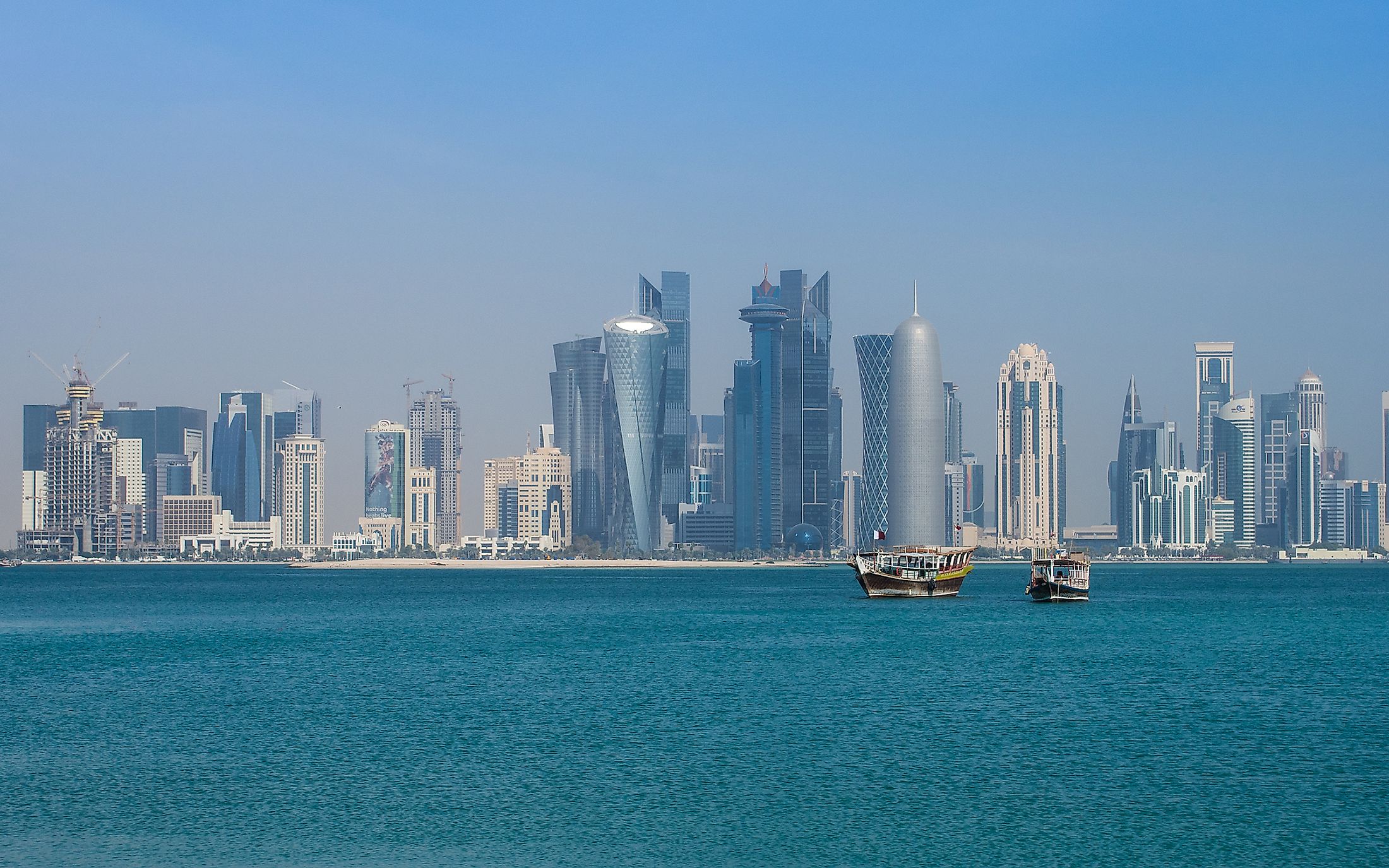
Persian Gulf
What Is The Persian Gulf?
In oceanography, a mediterranean sea (not to be confused with the Mediterranean Sea) is a sea that is almost enclosed by land and has limited water exchange with the Global Ocean. The water circulation in these seas is dominated by temperature and salinity differences rather than tides or winds. Two types of mediterranean seas exist: concentration basin and dilution basin. A concentration basin has a higher salinity than a dilution basin. Mediterranean seas are mainly located in the Atlantic and Indian Oceans. The seas in the Atlantic Ocean are the namesake Mediterranean Sea, Baltic Sea, Arctic Sea, and the Baffin Bay. Most of these mediterranean seas in the Atlantic are dilution basins. Two main Mediterranean seas in the Indian Ocean are the Red Sea and the Persian Gulf, both of which being concentration basins.
Where Is The Persian Gulf?
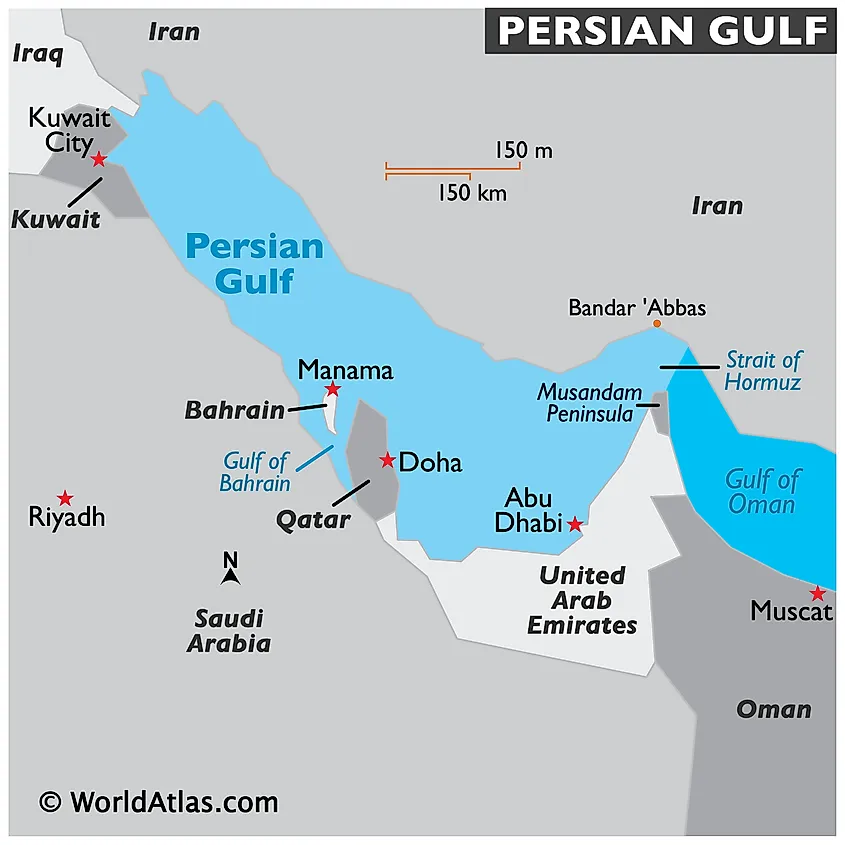
The Persian Gulf, a mediterranean sea, is part of the Indian Ocean. It is located in Western Asia. It is an extension of the Gulf of Oman and connects to the Indian Ocean via the Strait of Hormuz in the east. The Persian Gulf is also referred to as the Arabian Gulf or Gulf of Iran. It covers approximately 251,000 km2, with a maximum depth of 90 meters and an average depth of 50 meters.
The Persian Gulf lies between Arabian Peninsula and Iran to the southwest and northeast respectively. The water body is bounded by several countries, including Iran to the north, Qatar, Saudi Arabia, and the United Arab Emirates on the peninsula, and Bahrain, Iraq, and Kuwait in the northwest. It has a coastline length of about 5,117 km, with Iran having the longest coastline (1,536 km).
Origin Of The Name
The Persian Gulf derived its name from the Persis, a region southwest of the Iranian plateau. Under the Achaemenid dynasty, the ancient Persians in the Persis region became strong rulers and extended their reign as far as Eastern Europe and Indus Valley. According to Greek scholars, the body of water bordering the Persis region was named the “Persian Gulf.” Before the current name, the gulf was known by several names, including the Red Sea and “Sea above Akkad.”
Although the gulf is internationally and historically known as the Persian Gulf, some Arab countries have disputed the name. Since Iran is also called Persia, rival Arab states would rather call the gulf by alternative names. The emergence of Arab nationalism and pan-Arabism resulted in the invention of the name “Arabian Gulf.”
The Climate Of The Persian Gulf
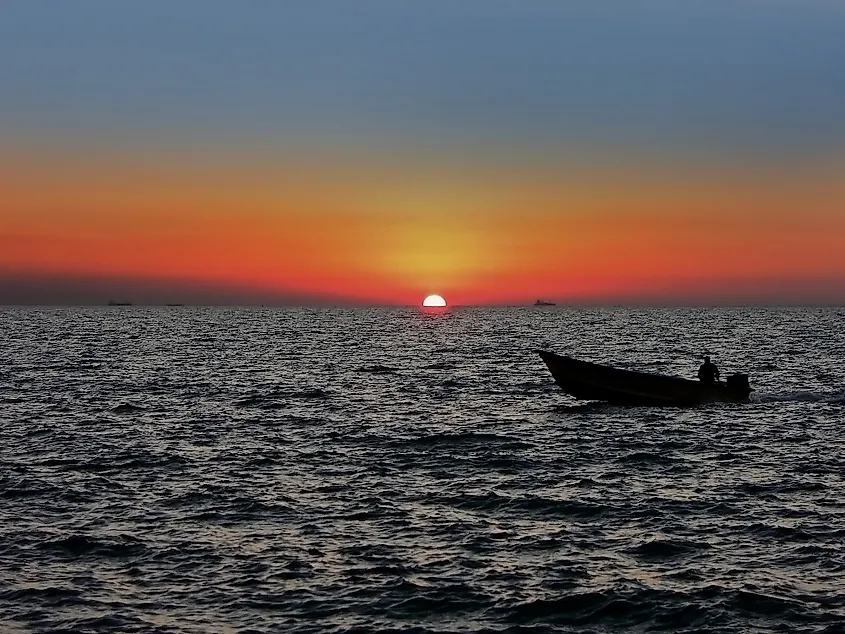
The Persian Gulf is popular for its notoriously unfavorable climate. Temperatures are extreme throughout the year, although winters may be cool, especially in the extreme northwestern regions. Precipitation or rainfall is sparse and mainly characterized by sharp downpours from November to December. The region experiences more cloud cover in winter than summer. Although fog and thunderstorms are rare, haze and dust storms are common during winter.
The surface water temperature ranges between 75 and 90 degrees Fahrenheit in the Strait of Hormuz to 60 to 90 degrees Fahrenheit in the northwest. The low freshwater inflow and high temperatures result in a high freshwater evaporation rate. Thus, the gulf’s salinity ranges from 37 to 41 parts/1000.
Islands In The Persian Gulf
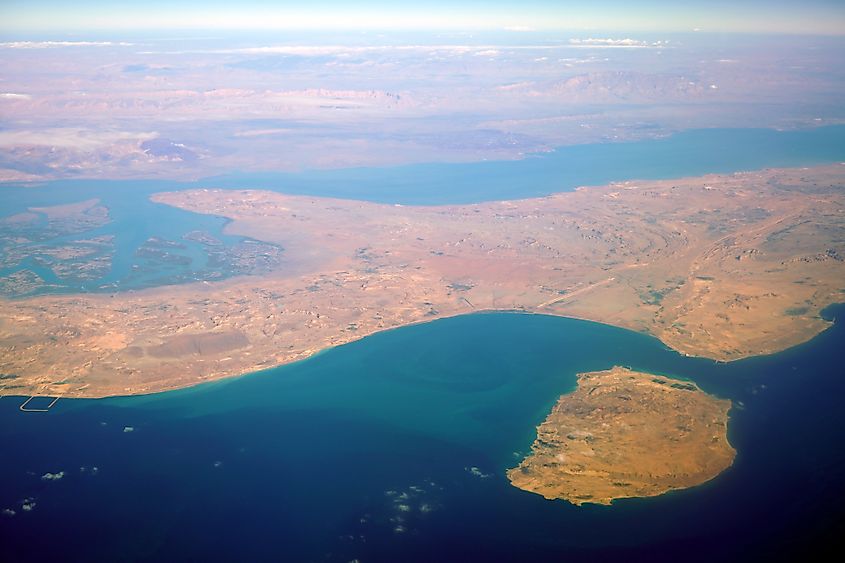
There are several islands in the Persian Gulf, including Bahrain, the Persian Gulf state. Bahrain comprises over 50 islands centered on the Bahrain Island. It has a 161-km coastline and claims 22 km of the territorial sea. Bahrain Island is the fourth-largest island in the Persian Gulf.
The islands in the gulf are distributed across the entire geographic area. Some of these islands are artificial and serve as tourist resorts. The islands are claimed by the different states bordering the gulf. Iran has the most islands, with some of its islands like Abu Musa, Greater Tunb, and Lesser Tunb claimed by some of the UAE’s emirates.
Qeshm Island is the largest island in the Persian Gulf, covering approximately 1,491 km2 (almost 2.5 times the size of Bahrain). The arrow-shaped island is located in the Strait of Hormuz, close to the south coast of Iran. It has a population of about 118,000 people.
Bubiyan Island, located in the gulf’ northwestern corner, is the second-largest island, covering 863 km2. The island is low and flat and mostly covered by salt marshes, making it uninhabitable. Bubiyan belongs to Kuwait. Other Islands include Amwaj and Jidda (Bahrain), Abu Musa and Buneh (Iran), Failaka and Miskan (Kuwait), and Arabi and Tarut (Saudi Arabia)
Marine Life And Protected Areas
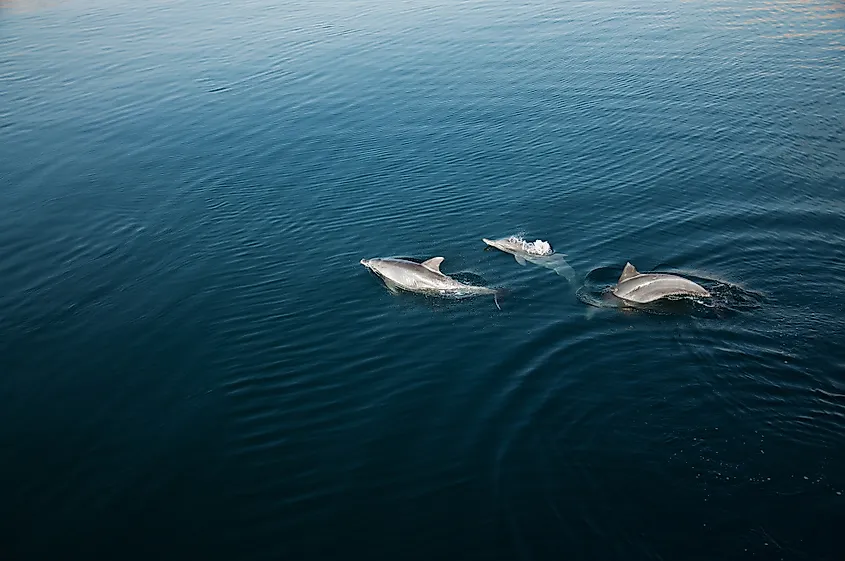
Persian Gulf’s isolation from international waters makes its wildlife unique and diverse. It is home to some magnificent flora and fauna, some of which are facing extinction. Besides global factors, activities in and around the Persian Gulf have endangered its wildlife.
The most common marine animals in the Gulf and neighboring Mediterranean region are the finless porpoises. Orcas and whales are rare due to overfishing and illegal mass hunting. Omura’s whale, humpback whale, and mink whales still swim into the gulf. Dugong, also known as sea cow, are also common in the Persian Gulf, the creatures resemble cows and graze on seagrass.
The Persian Gulf also hosts several local and migratory bird species, including collared kingfisher, booted warbler, and greater flamingos. The gulf is home to over 700 fish species. Most of these fish species are native and live around reefs. Some of the fish species found in the gulf are barracuda, goatfish, groupers, mackerel royal, tuna striped, and serial.
Several factors have affected the Persian Gulf’s ecosystem, including the Gulf War, improper waste disposal, oil spills, and real estate development. With few environmental watchdogs in the region, there are concerns over the misuse of the gulf and the developments around. At present, only about 3% of the gulf’s marine and coastal surface is protected. However, some of these protected areas are not well-managed. The designation of management areas is hampered by unclear ecosystem boundaries and species and habitat distribution. There are no MPAs for fisheries.
Brief History
Humans may have settled on the Persian Gulf shores as early as the Old Stone Age. Sumer, the earliest known civilization, began around the gulf and Mesopotamia. The nomadic tribes settled and ruled southern shores, later becoming the site for the Dilmun civilization. The Lakhum tribe migrated to the north coast and established the Lakhmid Kingdom. From 625 BCE to 226 AD, several empires dominated the northern part, including the Achaemenid, Median, Parthian, and Seleucid empires.
Although the Portuguese dominated the gulf for about 250 years, the colonialists had to contend with the local rulers and the Ottoman Empire. In 1521, the Portuguese invaded and took over Bahrain and established the pearl industry. From 1763 to 1997, the British Empire also had political control over some parts of the gulf, including Tricial States, Kuwait, and Qatar. The UK still maintains a profile in the region.
The US influence in the gulf became prominent in the second half of the 20th century. Its military personnel shot down Iran Air Flight 655 on July 3, 1988, while flying over the gulf, killing all 290 passengers and crew.
Human Settlements Along The Persian Gulf
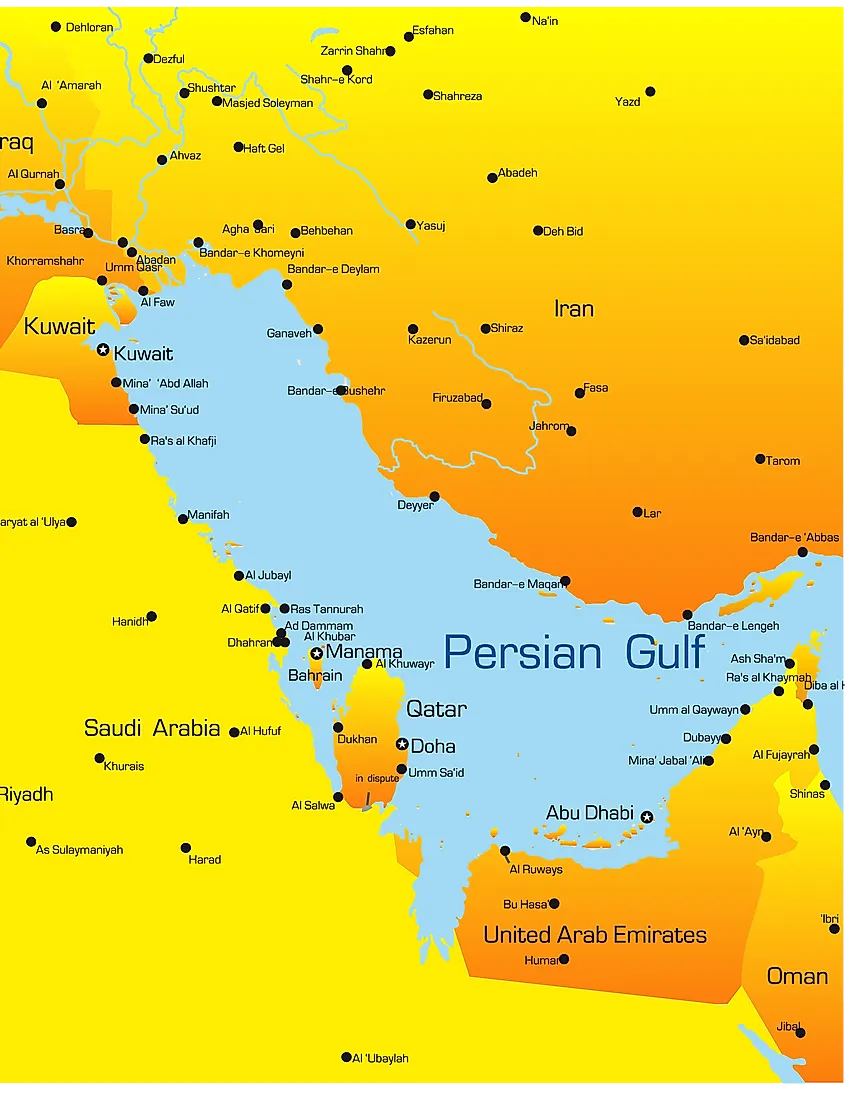
The countries surrounding the Persian Gulf have a combined population of about 100 million people. Although Iraq has the shortest coastline, it is the most populous Persian Gulf State, with about 41.2 million people. The gulf’s strategic location has made it ideal for human settlement.
Some of the Middle East’s biggest cities are located along the Persian Gulf coast. Dubai, the UAE’s capital and largest city, has a population of about 4 million people. Abu Dhabi, also a city in the UAE, has a population of about 1.5 million people. Kuwait’s capital, Kuwait City, is also located along the gulf coast. The city has a population of about 4.1 million people. Other popular cities along the Persian Gulf are Al-Faw (Iraq), Bandar Abbas (Iran), Khobar (Saudi Arabia), and Doha (Qatar). Bahrain, with a population of about 1.7 million people, is the only country located entirely in the gulf.
Economy
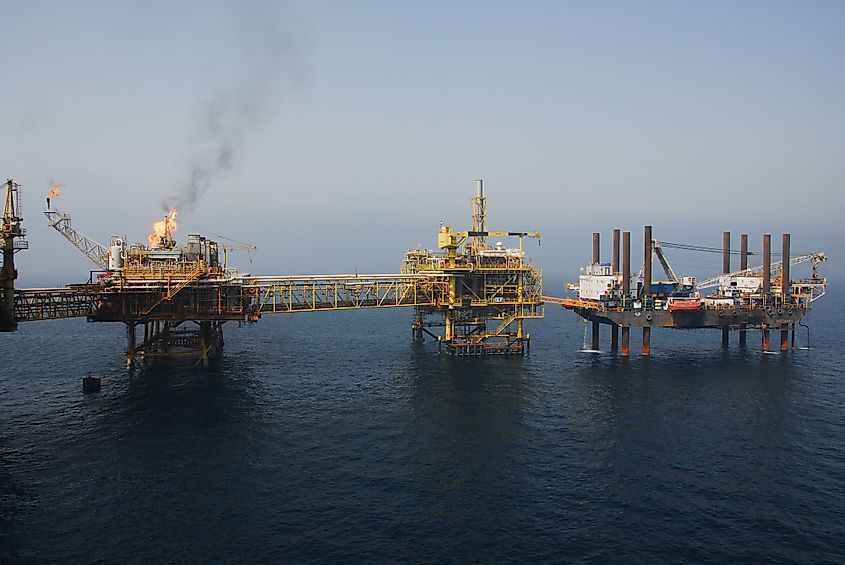
The Persian Gulf exclusive economic zone covers 240,756 km2, with Iran accounting for 97,860 km2. Before Iran discovered oil in the Persian Gulf, the gulf was mainly important for fishing, dhow building, pearling, sailcloth making, and date growing. The arid surrounding did not support many economic activities. Fishing remains an important activity for the people living around the Persian Gulf. It is highly commercialized, with large fishing industries set up in countries like Bahrain, Kuwait, and Qatar.
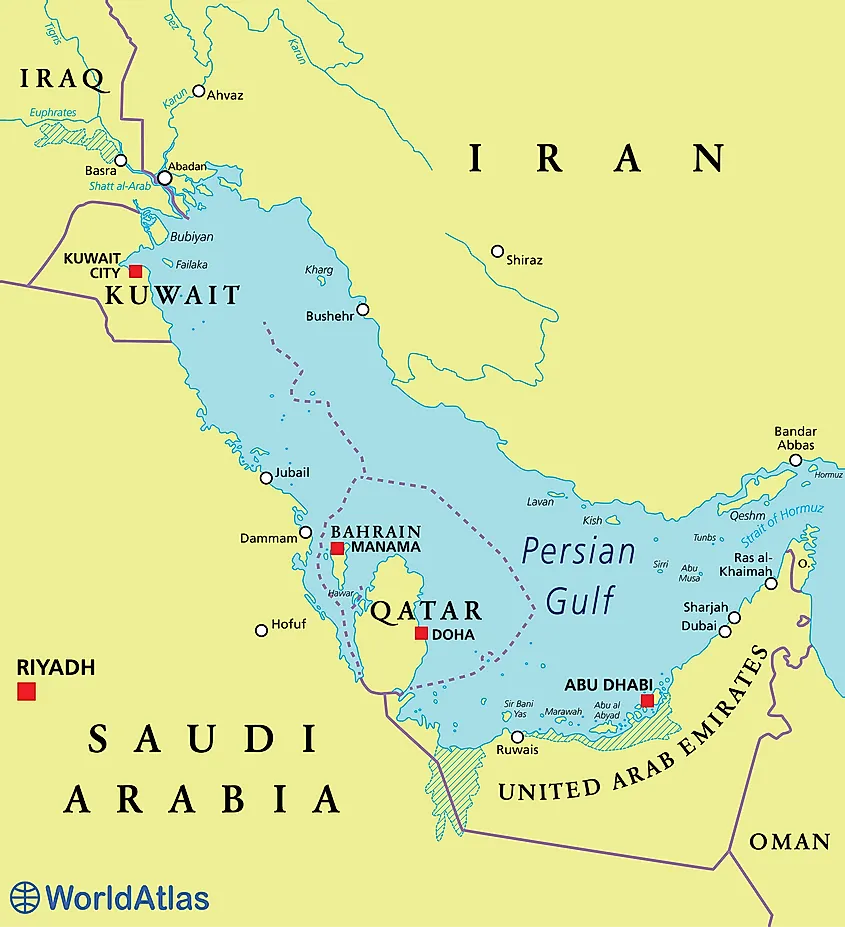
The Persian Gulf and surrounding countries are major oil and gas producers. The area has about two-thirds of the world’s oil reserve and one-third of the estimated natural gas reserve. Exploration is ongoing, with new deposits discovered offshore. However, control of the oil and gas reserves has led to conflicts between the surrounding nations. In 2002, the UAE, Saudi Arabia, Qatar, Kuwait, Iraq, and Iran produced almost 25% of the global oil. These oil-rich countries with the coastline on the gulf are referred to as Persian Gulf states.
|
Feature |
Fact |
|
Surface Area |
251,000 km2 |
|
Maximum Depth |
90 m |
|
Average Depth |
50 m |
|
Maximum Length |
989 km |
|
Width at narrowest point |
56 km |











